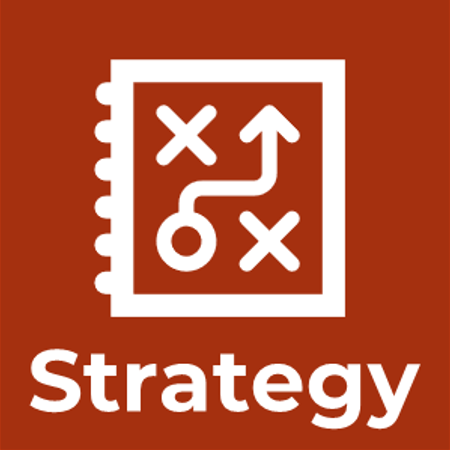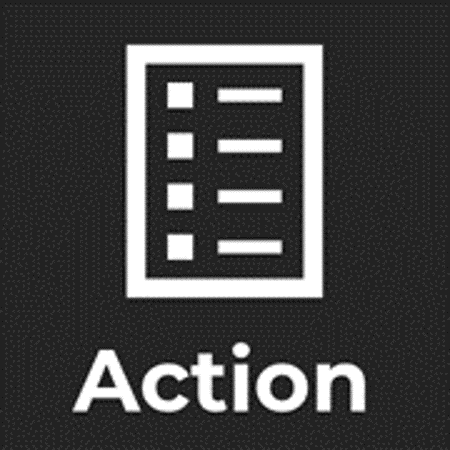
The Strategy4Action Framework is a step-by-step guide to define or fine-tune your company's Strategy and put it in Action. In 3 Steps:
If you don’t have the internal resources and want to create a Strategy or a Business Plan for your company, you will see that trying to find help is not easy. Unless of course you hire expensive consultants. Well, you can find online information on what a Strategic Plan or a Business Plan should contain relatively easily. But you can’t build a Strategy without doing the proper analysis and, for that, there is less help, and most of it comes from a few complex and scholarly books or posts that are not easy to master (that’s what I’ve had to master along with a lot of experience). Finally, if you want a confident way to put it in action, there is very little, if any, specific help out there – but, at the end of Strategy4Action it will be as if you can see it happening!
The videos of the program cover all of this from Analysis, to Strategizing, to Action. You can try to do it yourself. But you will find that, since this is a top-level comprehensive program, you may need help coordinating it and making it happen. For that, please contact me,
Luis Gato

is built upon the best consulting practices and the best of academia!
We use Strategy methods from Harvard Business School’s Michael Porter and teachings from other scholars and consultants like Gary Hamel, Bruce Greenwald and others, to tools learned during my MBA and my recent Wharton program on Strategy and Management for Competitive Advantage.
Throughout this program you will also see several references to tools created by the top management consulting firms.
I also bring my own 25+ years doing Strategic Planning for firms in different industries.
You will also see several examples from top global enterprises to some local companies.
Overview:

How much time do you dedicate to Strategy? How structured does that process turn out to be? Do you have enough people to make it happen? With 3 main and indispensable building blocks – Analysis, Strategy, and Action – the Strategy4Action Framework is a step-by-step guide to define or fine-tune your company’s Strategy and put it in Action.
Gato Consulting is here to support you in that process. Watch an overview of the process on this video:
The 3 main steps:
Step 1- Analysis
The analysis also has 3 parts. There is the external analysis, the internal analysis (looking inward at the company). Finally, we put it all together….

In each of the 23 highlighted steps, we will end with a summary of Strengths, Weaknesses, Threats, and, most importantly, OPPORTUNITIES. Yes, we will have 23 points in time where we will stop and think – what in here can we take advantage of or must pay attention to?!
You don't have to be a visionary or lucky to find the right OPPORTUNITIES.

First, we will look at your current Products and Segments (#12) vis-à-vis the market analysis done within the external analysis. Then, we will look at your Value Chain (#13). We will also look other resources such as Financial (#14), Intangible (#15), and Systems & IT (#16). We will also take a look at your Organization (#16) including Human Resources, Culture, your current Values and Purpose.
For this program we will work with a Strategy Team composed of the CEO, Top Leadership, and your other best minds, including up-and-coming managers and Key Process Owners. In several occasions we will also reach out with questionnaires to all your employees.

At your company, you have access to a spring of ideas and potential energy, and it’s basically free. Let’s tap into them and harness the knowledge of your employees!

Interested in our services?
Want to know more?

How often do you take a step back to make sure you’re not missing anything in terms of Macro Trends (#1) or Market (#2) information? How well do you really know your Customers? How about those that are not your customers and could be? How about your Competitors (#3)? The Strategy4Action Framework has a very detailed toolset for this and can help you refresh or create a top-level monitoring system for your market.
Industries are not just made of Competitors and Customers. The 5 Forces Model is one the most famous Strategic tools to analyze an Industry in all its forces. With the 5 Forces Model we will look at Buyers (#4), Substitute Products (#5), Suppliers (#6), Barriers to Entry (#7), and Industry rivalrly (#8) to measure your Industry’s Structure and Attractiveness. Most of the time an industry evolves slowly. Being up-close you may not even notice some of its changes and you may have a solidified view of it while, nonetheless, it is moving. So, every once in a while you must take a refreshed look at the industry and its trends and, importantly, how you can try to shift the power you have versus each of the forces to your favor. And you can also try to take advantage of the industry in its Lifecycle(#9) as well as in any Consolidation moves if the industry is still Fragmented. This is a complex and difficult analysis, but the Strategy4Action Framework has a pragmatic toolset for it.
We look at differentiation differently. We really do. Perhaps you think that there is nothing left to differentitate and that may (unlikely) be the case. But Strategy4Action has several structured tools to find differentiation and a few of them are on this video. By analyzing Customer Needs and Competitors we can estimate Customer’s Willingness-To-Pay (#10) for your products and its potential differentiating features, optimizing your Value Proposition. The tools we have for determining the Critical Success Factors (#11) you must master also contribute to finding differentiation factors. Not to mention other tools in the Framework that we show in other videos like the market questionnaire, engaging your employees, looking at substitute products, and product development.th

The Growth/Share Matrix (#17), aka BCG Model, is a valuable way to look at your business portfolio and how it might affect the future Cash Flow of your company. Then, and importantly, based off all the steps we went over previously, we will be building an ever-growing and prioritized SWOT. But this is a different SWOT in that (i) it includes a Short-Term and a Long-term perspective and (ii) it forces one to think of actionable suggestions to act on Opportunities, Threats, Weaknesses, and Strengths. We will end with an analysis of your Core Competences and Competitive Advantage (#18) – the most important concept in Strategy (which we will explain in the Video as well).
This video includes a sneak preview at the proprietary Strategy4Action Framework Toolset - over 100 templates for analysis, questionnaires, and discussion scripts.
Step 2 - Strategizing
Step 2 is also composed of three parts…


On the heels of the Analysis Wrap Up, we will use Michael Porter’s Generic Strategies’ framework to pick one for your company and then we will define what is the Competitive Advantage(s) you will be building and the Core Competences that should support it, whether you have them or need to enable them.
Then, we will create or fine-tune your Vision, Mission and/or Purpose statements, and what are the Values and/or Behaviors you want to uphold in the company.
And because we have a compilation of Opportunities we will create a draft definition of Long Term Goals that will be fine-tuned when creating Financial Projections.
These elements form what can be called The Big Picture. It’s like a flag that shows the way towards a challenging and exciting goal that has been established and much desired. At the same time, it’s a framework for decision making, clarifying priorities and defining what you do and what you don’t do. Finally, it’s a source of inspiration to everyone in your organization for the foreseeable future.
When did you last take the time to review or consider the elements of “The Big Picture”? How solid was that effort? Strategy4Action brings you the best practices on it and facilitates that work.
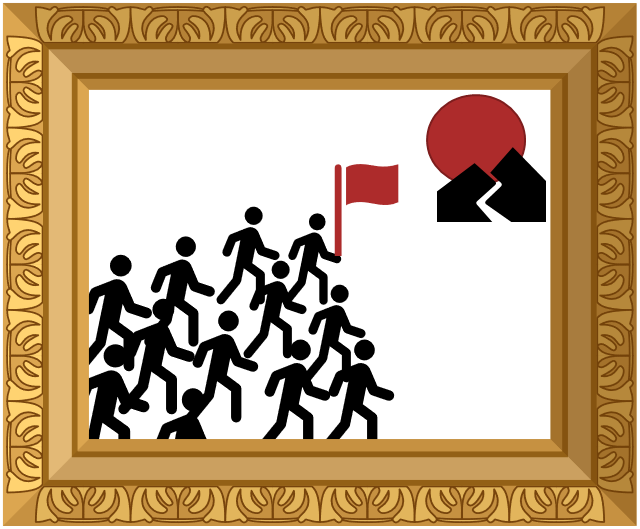
As we start Strategizing, and every step along the way, we will be asking for actionable suggestions and for revenue and expense estimates. For instance, if we need to develop a certain Core Competence, we will be identifying what needs to be done to make that happen and how much it might cost. Those tasks and projects will come in handy when creating the Action Plan!

The 6 Key strategic decisions are called as such because they are the types of decisions that can really move the needle for your company and make the difference from moving slow and steady to growing by leaps and bounds. They involve some analysis though, that’s why they are the last few of our 23 steps looking for Opportunities and you must go through these last exercises to find the largest opportunities.
The Key Strategic Decisions are Product Development (#19), Geographical Expansion (#20), Vertical Integration (#21), Capacity Expansion (#22), and Business Diversification (#23). On top of that we will dive into the 6th decision – Corporate Development – or whether you might be making any of the previous decisions through Organic Growth, Alliances/Joint Ventures, and/or M&A.
Strategy4Action uses Blue Ocean Strategies' frameworks to search for valuable innovation in Product Development.

We have established “The Big Picture” which sets the framework for future decision making at your company. We ended the search for Opportunities with the 6 Key Strategic Decision that can really make the difference for your company. The last step in strategizing is to go through your compiled SWOT and prioritize all the actionable suggestions we gathered for Strengths, Weaknesses, Opportunities, and Threats and group them into a handful of main Opportunities and Initiatives.
What do you talk about when you talk about your Strategy? In this video, we will unveil the components of a great Strategic Statement that summarizes your Strategy!
Step 3 - Action
Once they have figured out their Strategy, most companies will write it on a paper, assign executives to their goals, and hope it happens. As the saying goes, “hope is not a strategy”. Strategy4Action goes much deeper than that…

You can’t expect Strategy to be put in Action with things as they are at your company. Therefore, the first thing you must do is to make sure all resources – human and otherwise – are aligned.

There is not a lot out there in terms of case studies or scholarly research on how to put Strategy in Action. The best Model is McKinsey’s 7S Framework which compels companies to look at several areas of the organization and get them aligned. Strategy4Action developed a few intuitive techniques to make sure that, as we investigate the different areas of the organization, actionable suggestions are generated to make sure each area support the company’s Strategy. This includes looking at your Skills, your Value Chain, Systems, Organizational Structure, Culture and Shared Values. One important additional step we included will improve the Coordination among the different departments and/or divisions of your company which is extremely important when implementing Strategy and making a company more efficient.
The Strategy4Action Framework has a several tools to make sure everyone and everything is on the same boat and paddling in the same direction.

What’s a Strategic Plan without Financial Projections? or Financial Projections without a careful strategic reflection? We will create monthly, detailed P&L, Balance Sheet, and Cash Flow Statements. What is different about Strategy4Action is that we will add Calibration mechanisms to make sure you’re neither too optimistic or pessimistic, creating projections that you can bank on.
Another differentiating aspect of Strategy4Action is that it uses calibration tools to reduce Bias and Noise throughout the decision-making process of coming up with your Strategy and putting it in Action.
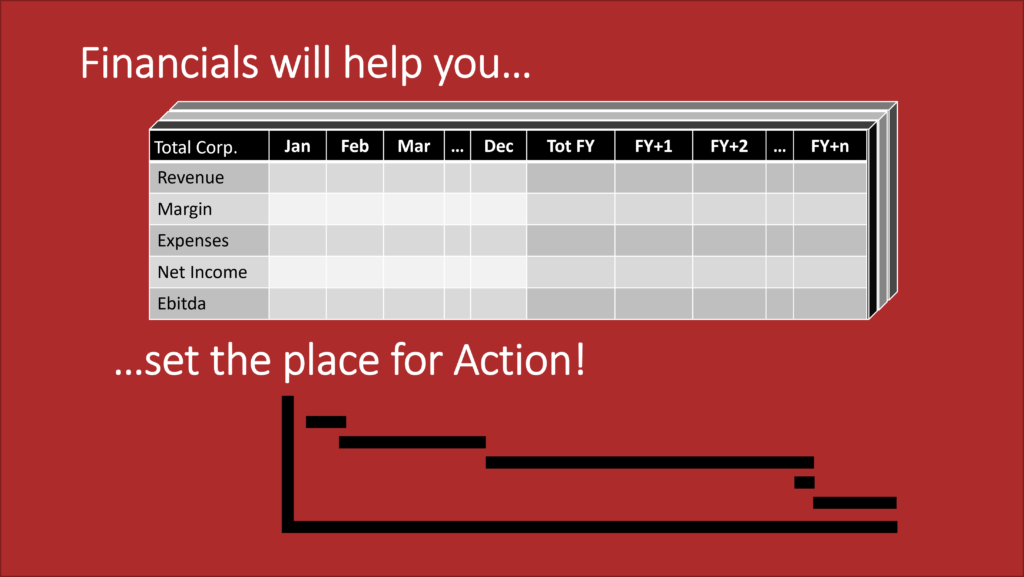
When you do your strategy work with a great financial model, you can count on your financials to help you set the pace for action and add value by putting banks and other investors on your side as you establish a track record of credibility behind Financial Projections you consistently meet because they were done with an excellent process.
We will complement the Financial Projections with a company Valuation using a couple of methods and explore “Big Hairy Audacious Goals” – BHAG – that can help motivate everyone in your company.

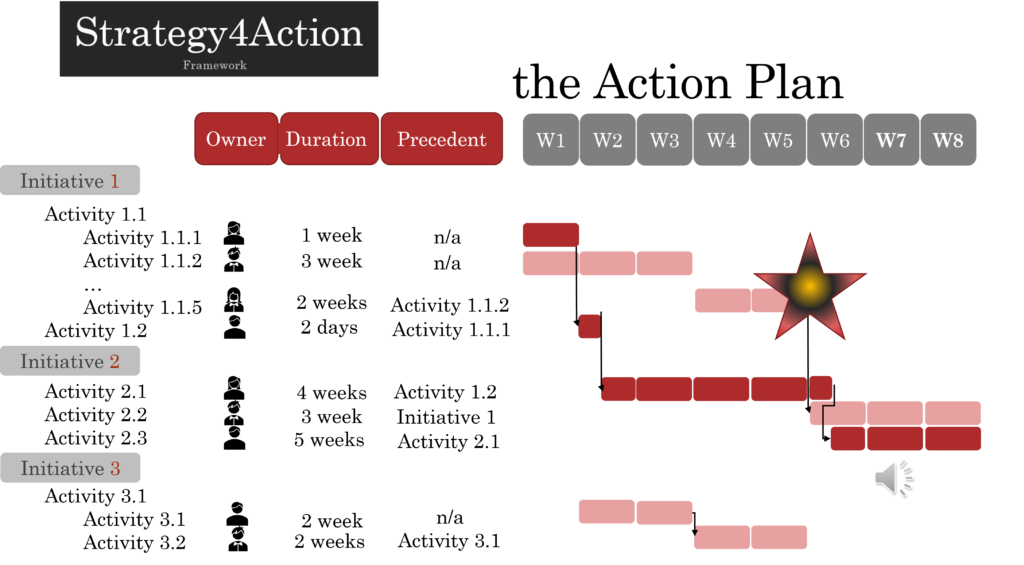
As soon as we start strategizing, and going through each step, there are repeated calls for actionable suggestions, and this is the final step where we put it together into a master action plan.
And for this, we’ll resource to the best Project Management and Strategy Execution practices. In this step we will create a detailed Gantt Chart or charts with all tasks that must be accomplished. Each activity will also have a sufficiently clear Scope, someone to Own it, a Deadline, and a Project Budget to put your Startegy in Action!
What you will get from this program is a great detailed Action Plan that will give you confidence your Strategy will be set in motion. How does one get from your Strategy to the Action Plan is what we explain in this video.
Now, you have a Strategy and you have a Plan!
Go for it.
You will achieve your goals!
So, how is

different?
#1 - Searching for Opportunities using 23+ methods that will leave no stones unturned.
You don't have to be a visionary or lucky to find the best opportunities!

#2 - Several techniques make the best use and engage your company's best minds, not just a couple of people.
These "crowd wisdom" techniques yield more ideas and help improve decisions by reducing noise and bias.

#3 - We use calibrating methods in building Financial Projections – one thing is being ambitious; another is flying to close to the sun.
This will help you build credibility with your stakeholders.
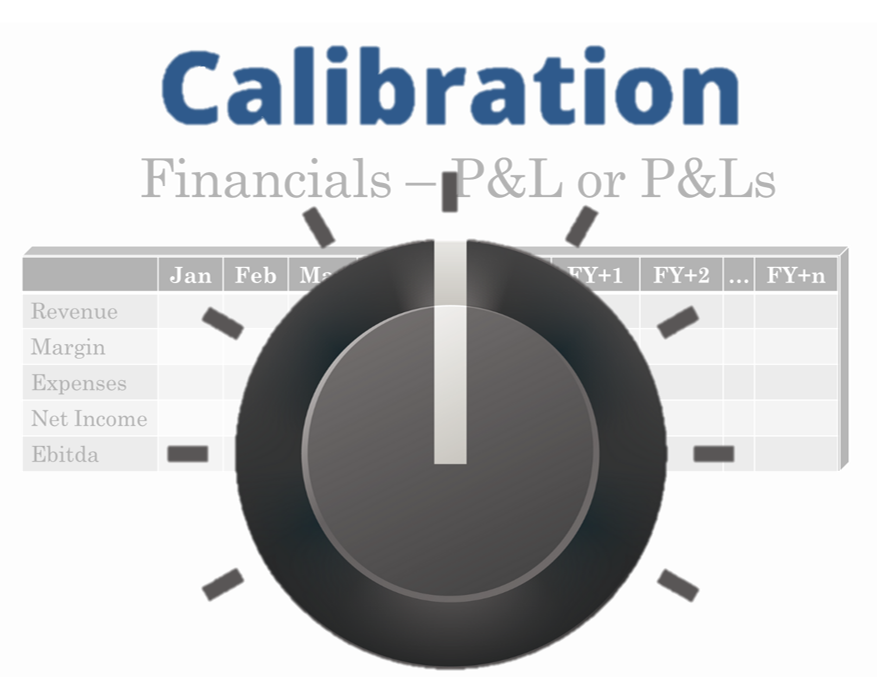
#4 - Practical and intuitive approach to Action because even the best Strategy books don't tell you how to do it.
This might be the only framework showing exactly how to put your Strategy in Action.

#5 - Consultant working with Your Team, locally, on-site as much as you want, and...
affordably!


